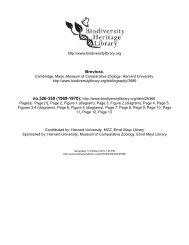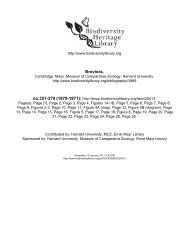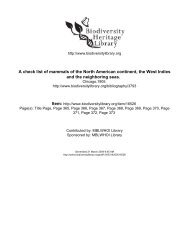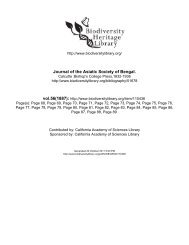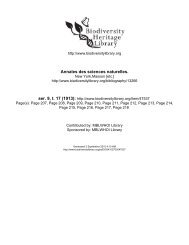A synopsis of the genera of reptiles and Amphibia, with a description ...
A synopsis of the genera of reptiles and Amphibia, with a description ...
A synopsis of the genera of reptiles and Amphibia, with a description ...
You also want an ePaper? Increase the reach of your titles
YUMPU automatically turns print PDFs into web optimized ePapers that Google loves.
Bodi/ covered <strong>with</strong> imbedded hard plates; legs distinct.<br />
Ears closed <strong>with</strong> a valve Emydosauri,<br />
Ears naked, valveless SaurJ.<br />
Body covered toith scales, or tico large shields.<br />
Legs 2-4 weak ; ears naked SacRophidii.<br />
LegsO; earsO Ophidii.<br />
Legs 4 ; body covered <strong>with</strong> two shields. . . Chelonii,<br />
Mr, Macleay, in his excellent Horcd Entomologies, has<br />
observed that <strong>the</strong> order <strong>of</strong> this class appears to assume a circu-<br />
lar disposition ; <strong>the</strong> most visible break m this arrangement is in<br />
<strong>the</strong> passage between <strong>the</strong> snakes <strong>and</strong> <strong>the</strong> tortoises ; for <strong>the</strong> con-<br />
nexion between <strong>the</strong> latter order <strong>and</strong> <strong>the</strong> crocodiles must be visi-<br />
ble to every one, if <strong>the</strong>y only consult Shaw's figure <strong>of</strong> <strong>the</strong><br />
Testudo serpentina, <strong>and</strong> compare it <strong>with</strong> that <strong>of</strong> <strong>the</strong> crocodile, for<br />
it is in fact a crocodile <strong>with</strong> a shortened body, covered <strong>with</strong><br />
united instead <strong>of</strong> distinct shields, <strong>and</strong> a bird's beak. The pas-<br />
sage from <strong>the</strong> crocodiles to <strong>the</strong> lizards by means oiihQMinitors,<br />
has long been known to naturalists, who have <strong>of</strong>ten considered<br />
<strong>the</strong> latter as species <strong>of</strong> <strong>the</strong> former genus ; <strong>and</strong> even Linnaeus<br />
placed <strong>the</strong>m in <strong>the</strong> same section <strong>of</strong> his genus Lacerta. The<br />
Sines have always been placed in <strong>the</strong> same genus or group <strong>with</strong><br />
<strong>the</strong> lizards ; but <strong>the</strong>ir affinity <strong>with</strong> <strong>the</strong> slow-worms did not escape




